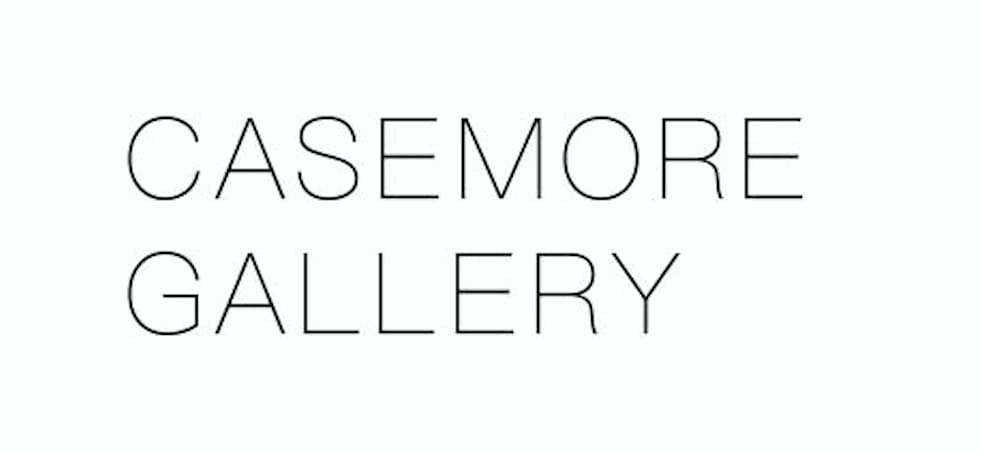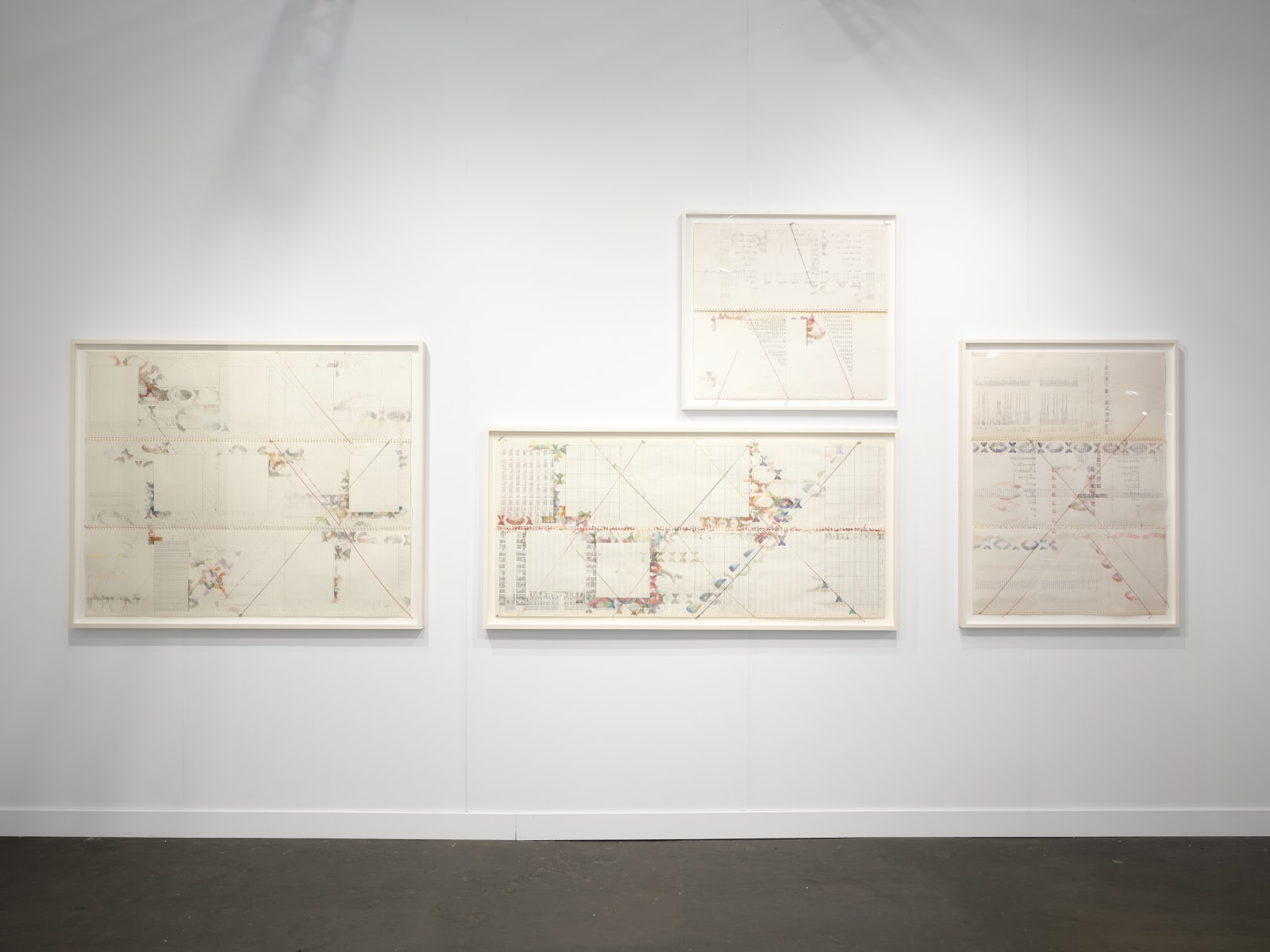FOG Design+Art Fair 2024
Casemore Gallery is pleased to present work by Sonya Rapoport, Raymond Saunders, Sean McFarland, and Henna Vainio for FOG Design+Art 2024.
Sonya Rapoport began using the computer in her practice in 1976, when she found discarded continuous-feed computer printout paper in a bin in the basement of the UC Berkeley mathematics building. Drawn to the futuristic aesthetic of sprocket holes, grid lines, and carbon-black, dot-matrix printed code, she drew into the existing patterns with graphite, colored pencil, and ink stamps, and stitched the construction together with colorful yarn. In 1977 Rapoport wrote, “my work is an aesthetic response triggered by scientific data. The format is computer print-out, a ritualistic symbol of our technological society.” By the early 1980s, Rapoport had learned to code and was using the computer to analyze and visualize data. At a time when computers were primarily used for business, science, and military applications, Rapoport was gathering and processing data about what she called “soft material,” including her biorhythms, her shoe collection, her home, and the objects on her dresser, an approach she characterized as a feminist use of new technology.
Sonya Rapoport (1923-2015) was an American artist with a pioneering conceptual, feminist art practice spanning six-decades. Rapoport was among the first women to receive an MA in Painting at UC Berkeley in 1949. She was active in a community of artists experimenting with technology and psychology, taking a leadership role in the new media journal Leonardo (MIT Press). Rapoport’s opulently colored, enigmatically structured paintings from the early 1970’s feature a coded language of stencils representing the female body. Later in the decade, Rapoport made a remarkable shift to embracing information technology. In the era of room-sized computers programmed with punch cards, at the time confined primarily to the purview of big business and scientific research, Rapoport began experimenting with continuous-feed computer paper. Drawn to the then futuristic aesthetic of sprocket holes, grid lines, and cryptic inscriptions, Rapoport drew into existing patterns with graphite, colored pencil, and ink stamps, and stitched constructions together with colorful yarn. She later programmed computers to create dense visual representations of information about her daily life, including her shoe collection, the objects on her dresser, and her family. Her legacy includes paintings, drawings, interactive computer installations, and web art.
Raymond Saunders uses humble materials in transformative ways. Weathered doors, shipping palettes, abandoned construction materials, found signage, newspapers, and various ephemera ground his paintings and assemblage constructions. Saunders uses what is at hand in his studio, even the tools of painting itself—wet paint brushes, pencils, and painter’s tape. Saunders adds swathes of improvisational marks in paint and oil crayon, and layers in his own visual language of symbols, hearts, domestic references, and paint drips, carefully applied to create texture and comingle with Saunders’ white pencil drawings on his signature black-painted backgrounds. A constant element in his work throughout the decades, these backgrounds often reference classroom blackboards, reflecting his memories as a student and his passion for educating, with white pencil and oil crayon mimicking the more ephemeral markings made by a teacher’s hand in chalk before being washed away at the end of a school lesson.
Raymond Saunders (1934) was encouraged from a young age to dedicate himself as an artist and pursue the highest opportunities in education to develop his innate talents. He was mentored by Joseph Fitzpatrick, a teacher in the Pittsburgh public school system who also taught Andy Warhol. After attending Pennsylvania Academy and Carnegie, Saunders received his MFA in 1961 from California College of the Arts (then California College of Arts and Crafts) in Oakland. Saunders made a home in Oakland soon after. In 1967, he published his seminal essay “Black is a Color,” which reflected his challenges to identity-based categorizations in art movements. He began his teaching career in 1968, joining the staff of California State University Hayward, where he remains professor emeritus. Saunders continues to make his home and center his artistic practice in Oakland, while throughout his career he has traveled the world, taking additional studios in Paris, France, and Venice, California.
Sean McFarland’s work explores the relationship between photography and the history and representation of landscape, exploring western landscapes and the skies above in particular. With a focus on experimentation, the artist joins aspects of other mediums with photography to uncover the experience of seeing, the passing of time, and the knowledge that we and what we know cannot live forever. McFarland asks us as viewers to consider whether photographs make us pay more or less attention to the environment around us. He is interested in the contextual relationship between us and the picture, and how we create meaning through it. He is interested in people’s inclination to hold faith in the accuracy of a photo’s depiction of the earth. Through alternative processes of photography such as cyanotypes—a photographic printing process that produces blue prints solely using coated paper and light, with no camera or negatives— there is a beautiful simplicity and purity in this representation of color and material. The work considers the emotions, or lack of emotions, that different representations evoke in us as individuals as we see and encounter these non-specific places.
Sean McFarland (California, 1976) received a MFA from California College of the Arts, Oakland (2004) and a BS from Humboldt State University, Arcata, California (2002). His solo exhibitions include the San Francisco Museum of Modern Art, San Francisco, CA (2017); Visual Studies Workshop, Rochester, New York (2015); San Francisco Camerawork, San Francisco (2009), and White Columns, New York (2004). His work has been included in group exhibitions at the Berkeley Art Museum and Pacific Film Archive, Berkeley, CA (2018); George Eastman Museum, Rochester (2016); Aperture, New York (2014-15); and Bay Area Now 6, Yerba Buena Center for the Arts, San Francisco (2011). His work is in the permanent collections at the San Francisco Museum of Modern Art; Berkeley Art Museum and Pacific Film Archive; National Gallery of Art, Washington DC; George Eastman Museum; and the Milwaukee Art Museum.
Henna Vainio's recent ceramic works focus on language in the form of word stacks. In language, understanding, imagination, and meaning intersect as we read, write, speak, and listen from beginning to end.In Vainio’s word stacks, the linear is disrupted as beginning and end are compressed in spacetime. The message becomes nearly impossible to decipher, but the letters remain with their message becoming nearly infinite.
Henna Vainio (Finland, b.1981) earned her MFA from The Slade School of Art, London, and her BFA from Chelsea College of Arts, London. Her solo and two-person exhibitions include Ben Peterson - Henna Vainio, 1599fdT, Mill Valley (2023); Hardstep, Josh Lilley Gallery, London (2019); More Life, Ratio 3, San Francisco (2018); Capital Gallery, San Francisco (2017) and Step of Two, Royal NoneSuch Gallery, Oakland (2017). She has also participated in a number of group shows in the UK, Finland and Germany.











